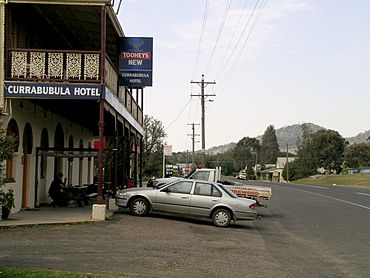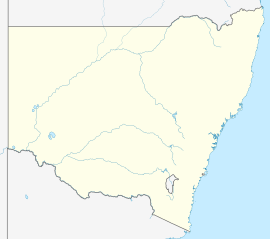Currabubula facts for kids
Quick facts for kids CurrabubulaNew South Wales |
|
|---|---|

The main street.
|
|
| Population | 332 (2016 census) |
| Established | c.1855 |
| Postcode(s) | 2342 |
| Elevation | 433 m (1,421 ft) |
| LGA(s) | Liverpool Plains Shire |
| County | Buckland |
| State electorate(s) | Tamworth |
| Federal Division(s) | New England |
Currabubula is a small village in New South Wales, Australia. It's located in a part of the state called the North West Slopes. This area is also part of the wider New England region. You can find Currabubula about 30 kilometres south-west of Tamworth. It is also 15 kilometres north-east of Werris Creek. Currabubula is part of the Liverpool Plains Shire, which is a local government area. In 2016, about 332 people lived in the village.
Contents
A Look Back: Currabubula's Story
Early Days and Name Origins
For thousands of years, the Kamilaroi Indigenous people lived in this area. The village's original name was "Carrobobella." This name came from the Kamilaroi language, which is the traditional language of the Kamilaroi people. When European settlers arrived, the name was changed to Currabubula.
Growing as a Village
Even before 1848, there was a place for travelers to stay in Currabubula. By 1854, or perhaps even earlier, an inn (a type of hotel) was open. The village itself was planned out before 1860. By 1862, Currabubula was important enough to be shown on county maps. A railway station was built here in 1878. It was part of the Main North railway line and served the village until 1985.
Life in Currabubula Today
Currabubula has its own public school for local children. There is also a hotel in the village. Each year, the Currabubula Red Cross Art Exhibition takes place here. This event showcases local art and helps support the Red Cross.
Farming and Horses
Farming is the main industry in the area around Currabubula. Important farm activities include raising beef cattle and sheep. Farmers also grow grain crops. Currabubula is also known as a "horse friendly" village. There are hundreds of acres of special land called Travelling Stock Reserves. These areas are perfect for people who enjoy riding horses on trails.


